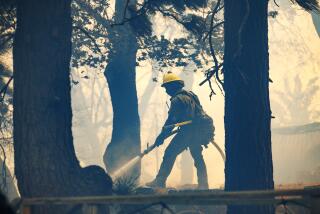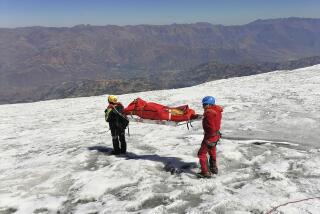Deadly quest for perfect powder
Two months into the winter sports season, avalanches have claimed 26 lives nationwide, including three near Mountain High Resort this weekend, in what officials warn may be a record year for mountain fatalities.
Avalanche experts say average annual death tolls have edged up from 20 to 25 over the last decade and are likely to increase as more people with better technology and a new “extreme sports” mentality venture into remote areas in search of untrammeled powder.
But even a seemingly innocuous snowpack can hide tragedy: Layers of snowfall, often interspersed with ice, can slough off at the slightest disturbance.
“There have been avalanche fatalities since people have been in the West and in the Alps, but what has changed is the equipment has gotten better and there’s a lot of hype associated with the outdoor retail industry,” said Sue Burak, an avalanche forecaster for the Eastern Sierra Avalanche Center. “They’re encouraging people to go out, and the level of backcountry skills haven’t caught up with the technology.”
Every avalanche fatality this year, except for one in Utah, involved a person who was skiing, snowmobiling or snowboarding outside of designated areas or in wilderness, with the majority of the deaths in backcountry. Only 1% of all avalanche deaths in the United States occurred within the bounds of skiing or snowboarding resorts. About 11% were out-of-bounds deaths, and the rest were in backcountry.
On Friday, three men were killed in avalanches near Wrightwood while skiing out-of-bounds in canyons adjacent to Mountain High’s groomed slopes. Two of the victims were members of the resort’s ski patrol, and the third was an experienced backcountry skier. Mountain High ski resort typically helps fill its slopes with man-made snow, leaving adjacent areas more bare. But the area had experienced 4 feet of fresh powder over the last few days. Another storm was expected Saturday night.
“In Southern California, having these big dumps of powder are not real common,” said Northwest Avalanche Institute expert Paul Baugher, an avalanche-safety instructor and ski patrol director at Crystal Mountain Ski Resort in Washington who often is called to investigate avalanche deaths. “And so there’s two things going on here. One is, people are sort of unfamiliar with how dangerous this can be. Even if you’re a professional, you don’t have that experience of actually seeing these [avalanches] released. On top of that, it’s so rare. It’s wonderful skiing, and you’re drawn to that.”
The Sierra Nevada and Cascades were primed for avalanches because of a spate of heavy fresh snow on top of a very lean snowpack. Experts say this makes areas especially ripe for avalanches because the snow layers are not well-bonded.
“Mechanically, it’s like putting peanut butter over jam; it’s top heavy, it doesn’t hold and it slides on the layers down below,” Baugher said.
Most avalanches are triggered by the victim or someone else in the group and occur on 30- to 45-degree slopes, equivalent to a black- or double black- diamond ski run -- the most difficult slopes.
One of the fastest-growing groups of victims are snowmobilers who often attempt to “high mark,” accelerating vehicles up steep slopes. Avalanches involving snowmobilers contributed to the record 35 fatalities in the 2001-02 season, according to databases.
New technology such as alpine recreational skis that provide more flotation, snowmobiles with larger skids and tracks, and equipment like the AvaLung, which allows people to breathe while buried in snow, have added to the thrill-seeker’s arsenal and false sense of security. Avalanche survival is the exception, not the norm: One in three victims survives full burial, experts say.
Of the 26 people killed in the U.S. this year, at least a third were equipped with avalanche gear or safety beacons that would help rescuers locate them, according to experts and avalanche data.
“People will spend thousands of dollars on really fancy ski equipment, on really powerful snowmobiles; they’ll buy avalanche beacons, rescue gears, shovels, spend all the money on the rescue gear but skimp on the training, which is the one thing that will prevent them from having to use it,” Baugher said. “We say the most important piece of equipment you take out into the backcountry is your brain.”
All three of the Wrightwood victims were experienced skiers, at least one of whom had previously skied the areas where the avalanches occurred.
The experienced skier faced with a new powder dump finds it hard to resist.
“Certainly in the past I’ve experienced the same thing,” said Alex Clayton, a ski patrol member and avalanche analyst who has spent seven winters working on Mammoth Mountain. “You get powder-hungry, or you’ve hiked all the way to the top of the mountain and you say, ‘Well, it’s marginal [risk], but we’ve come all this way.’ ”
Ian McCammon, a longtime avalanche researcher in Salt Lake City, found that the highly trained people often exposed themselves to more danger and made riskier decisions in familiar terrain. Those with a small amount of training often overestimated their abilities.
A few winters ago, Clayton was caught in an avalanche in an out-of-bounds area while he was on duty trying to secure the mountain.
“It’s like the sensation of being dragged under a wave, it’s just like that, only much brighter,” Clayton said. “Think about the worst crash you’ve ever had on a powder day, and then combine that with getting dragged under a wave for an extended distance. You can’t breathe, you’re inhaling all sorts of stuff, every now and then your head will pop out of the water and then you’ll get dragged back down.”
Clayton was able to dig himself out and had prepared himself as he slid about 150 yards so that he would not be fully buried.
Half of all avalanche victims die within 25 minutes of being fully buried in the snow, and 95% are dead within two hours, according to experts. Most victims die from the trauma of being dragged through trees or from asphyxiation.
“Avalanche debris is really dense,” Clayton said. “It’s like being in wet cement.”
--
-
(BEGIN TEXT OF INFOBOX)
‘FACETS’ of disaster
Six common traps to which avalanche victims often fall prey:
Familiarity: It must be safe; I’ve done it before.
Acceptance: I don’t want to be the one who says no.
Commitment: We’re going to ski that slope no matter what.
Expert halo: That person knows best.
Tracks: Other people have done it; people are watching me.
Scarcity: If we don’t get to that powder stash first, someone else will.
--
Source: Ian McCammon, avalanche researcher and certified instructor with the American Avalanche Assn.


